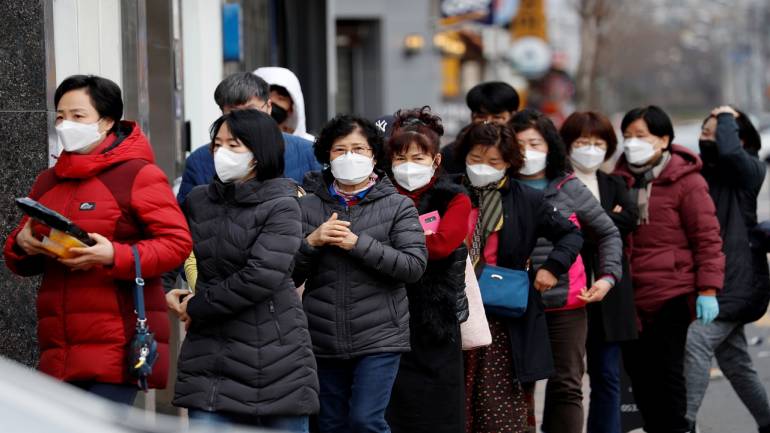Even if there is a limited outbreak outside China, a sharp slowdown in global growth is expected. The OECD now predicts that both China and India are expected to grow around 5 percent in 2020.
With more than 90,000 confirmed cases and about 3,000 deaths, the Coronavirus has already spread to more than 70 countries. Though the situation in China is somewhat stabilising, the new cases are being reported from Italy, Iran and other places.
The new cases reported in India have their links to Italy and Dubai. Union Health Minister Harsh Vardhan has informed that passengers are being screened at airports and seaports. He advised Indians to avoid non-essential travel to China, Iran, Korea, Singapore, and Italy. These restrictions could be extended to other countries.
By the end of January, the World Health Organization (WHO) had already declared the ‘outbreak of COVID-19 to be a Public Health Emergency of International Concern’. Now the WHO has increased the risk assessment to ‘very high’ across the world. As per the WHO, the spread can go in ‘any direction’. Apart from precautions, broadly no major travel or trade restrictions have been recommended so far.
Still, many governments have shut down schools and cancelled large public events. Airlines and hotels are witnessing significant cancellations. Tourism and civil aviation sectors are already beginning to feel the pain. Since people make their travel plans much in advance, this summer may be a difficult period for the travel and tourism industry. Overall business confidence is shaky due to closure of cities, quarantines, travel restrictions and supply chain disruptions.
Fearing recession and disruptions in global supply chains, world stock markets have already witnessed a bloodbath last week. Since the outbreak is recent and the direction is less clear, most multilateral institutions are cautious in explaining its medium- to long-term trade and economic impacts.
Even without factoring the outbreak of the COVID-19, the WTO had already warned that ‘world merchandise trade growth is likely to remain weak in early 2020’. With the virus impact, the situation in the second half will become more complicated. The WTO head now says that impact of the Coronavirus is going to be substantial. It will start to show up in the trade data soon.
The OECD now feels that Coronavirus presents the ‘global economy with its greatest danger since the financial crisis’. The global growth can be down as low as 1.5 percent this year, if there is a broader contagion across the wider Asia-Pacific region and advanced economies in Europe and the United States. Even if there is a limited outbreak outside China, a sharp slowdown in global growth is expected. The OECD now predicts that both China and India are expected to grow around 5 percent in 2020. Hardly any growth is now expected in Italy and Japan. Already reeling under trade and political tensions, the Coronavirus has given another blow to the global economy.
The travel industry in affected countries is the first to be impacted. China’s travel market is the largest in Asia and one of the fast-growing markets in the world. As per the World Tourism Organization, outbound China tourism expenditure in 2018 was $277 billion. In 2019, China received 145 million tourists and about 170 million Chinese made outbound trips.
The Chinese travel situation in 2020 will be drastically different. The impact of curtailing only Chinese movement was going to be drastic. Now it is going to be even bigger. Europe, one of the biggest tourist destinations in the world, is also under the COVID-19 scare. In 2018, Europe received more than 700 million visitors who spent $570 billion.
With events and business travel cancellations, the impact on tourism and aviation is underway. Demand for many products will fall as people are less likely to visit markets, restaurants and public places in affected countries. With estimated 320 million jobs and $5.7 trillion in revenue, the travel industry is one of the largest industries in the world. If the impact continues to affect beyond March, it will start affecting many other sectors.
The major worry is that the outbreak of the virus was not in some small peripheral developing economies, but it was in countries such as China, South Korea, Japan and some important European countries. These nations are at the centre of global production and trade networks.
China is at the centre of the global value chain in manufacturing. It is a major exporter of parts used in automobiles, computers, electronics and electrical equipment. A shut down of many Chinese cities will start impinging many of its trading partners soon. Indian industry will face problems related to imports to consumer electronics, synthetic yarn and fabric, automotive components and pharma raw material. Cotton yarn exports could also be affected. Some further disruptions are also expected from South Korea and Europe.
The virus continues to spread worldwide and the situation is changing by the day. It will definitely dominate most parts of trade in 2020. The negative spill over may not be limited to travel and global supply chains. The policy measures by countries in terms of restrictions and local production will negatively affect the process of globalisation further.













![Hotstar Premium Cookies 2019 [*100% Working & Daily Updated*] Hotstar Premium Cookies 2019 [*100% Working & Daily Updated*]](https://tahav.com/wp-content/uploads/2019/11/Hotstar-Premium-Cookies-Free-100x70.jpg)



